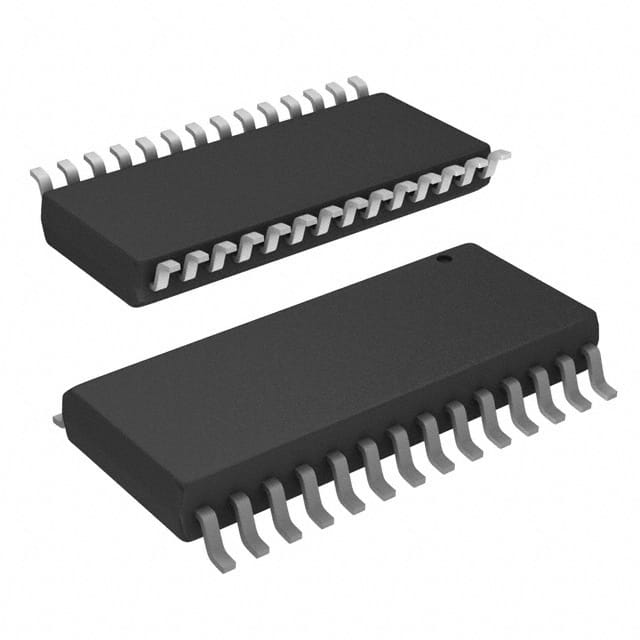Подробную информацию о продукте см. в характеристиках.

PIC18LF2520-I/SO
Product Overview
Category
The PIC18LF2520-I/SO belongs to the category of microcontrollers.
Use
This microcontroller is commonly used in various electronic devices and embedded systems for controlling and processing data.
Characteristics
- High-performance 8-bit architecture
- Low power consumption
- Enhanced Flash program memory
- Integrated peripherals for versatile applications
- Wide operating voltage range
- Robust communication interfaces
Package
The PIC18LF2520-I/SO is available in a small outline (SO) package, which provides ease of integration into compact designs.
Essence
The essence of this microcontroller lies in its ability to efficiently execute complex tasks while consuming minimal power.
Packaging/Quantity
The PIC18LF2520-I/SO is typically packaged in reels or tubes, with a quantity of 250 units per reel/tube.
Specifications
- Architecture: 8-bit
- Program Memory Size: 32 KB
- RAM Size: 1536 bytes
- Operating Voltage Range: 2.0V to 5.5V
- Maximum CPU Speed: 40 MHz
- Number of I/O Pins: 25
- Communication Interfaces: UART, SPI, I2C
- Analog-to-Digital Converter (ADC): 10-bit, 13 channels
- Timers: 3 x 8-bit, 1 x 16-bit
- PWM Channels: 2
- Operating Temperature Range: -40°C to +85°C
Detailed Pin Configuration
The PIC18LF2520-I/SO microcontroller has a total of 28 pins, each serving a specific purpose. The pin configuration is as follows:
- VDD - Power supply voltage
- RA0 - General-purpose I/O pin
- RA1 - General-purpose I/O pin
- RA2 - General-purpose I/O pin
- RA3 - General-purpose I/O pin
- RA4 - General-purpose I/O pin
- RA5 - General-purpose I/O pin
- VSS - Ground
- OSC1/CLKIN - Oscillator input
- OSC2/CLKOUT - Oscillator output
- RC0 - General-purpose I/O pin
- RC1 - General-purpose I/O pin
- RC2 - General-purpose I/O pin
- RC3 - General-purpose I/O pin
- RC4 - General-purpose I/O pin
- RC5 - General-purpose I/O pin
- RB0/INT0 - External interrupt input
- RB1/INT1 - External interrupt input
- RB2/INT2 - External interrupt input
- RB3/CCP2 - Capture/Compare/PWM pin
- RB4/SDI/SDA - Serial data input/I2C data
- RB5/SDO/SCL - Serial data output/I2C clock
- RB6/TX/CK - UART transmit pin
- RB7/RX/DT - UART receive pin
- RB8/PGM - In-Circuit Serial Programming pin
- RB9/PGC - In-Circuit Debugger clock pin
- RB10/PGD - In-Circuit Debugger data pin
- MCLR/VPP - Master Clear/Voltage programming pin
Functional Features
The PIC18LF2520-I/SO microcontroller offers a range of functional features, including:
- High-speed processing capabilities
- Flash program memory for storing code
- Data EEPROM memory for non-volatile data storage
- Integrated peripherals such as timers, PWM channels, and ADC
- Multiple communication interfaces for seamless connectivity
- Enhanced security features for protecting sensitive data
- Power-saving modes to optimize energy consumption
- Flexible I/O pins for interfacing with external devices
Advantages and Disadvantages
Advantages
- High-performance 8-bit architecture enables efficient execution of tasks.
- Low power consumption extends battery life in portable applications.
- Integrated peripherals provide versatility and reduce external component count.
- Wide operating voltage range allows compatibility with various power sources.
- Robust communication interfaces facilitate seamless data exchange.
Disadvantages
- Limited program memory size may restrict the complexity of applications.
- The number of I/O pins may be insufficient for certain projects.
- Lack of advanced features found in higher-end microcontrollers.
Working Principles
The PIC18LF2520-I/SO microcontroller operates based on the principles of digital logic and embedded systems. It executes instructions stored in its program memory, interacts with peripherals, and communicates with external devices as per the programmed code. By utilizing its integrated components and processing capabilities, it performs tasks according to the desired functionality.
Detailed Application Field Plans
The PIC18LF2520-I/SO microcontroller finds applications
Перечислите 10 распространенных вопросов и ответов, связанных с применением PIC18LF2520-I/SO в технических решениях.
What is the operating voltage range of PIC18LF2520-I/SO?
- The operating voltage range of PIC18LF2520-I/SO is 2.0V to 5.5V.Can PIC18LF2520-I/SO be used in battery-powered applications?
- Yes, PIC18LF2520-I/SO can be used in battery-powered applications due to its low operating voltage and power-saving features.What are the key features of PIC18LF2520-I/SO for technical solutions?
- The key features of PIC18LF2520-I/SO include a wide operating voltage range, low power consumption, and various communication interfaces such as SPI, I2C, and UART.Is PIC18LF2520-I/SO suitable for embedded control applications?
- Yes, PIC18LF2520-I/SO is suitable for embedded control applications due to its high-performance RISC CPU and rich set of peripherals.Can PIC18LF2520-I/SO be programmed using C language?
- Yes, PIC18LF2520-I/SO can be programmed using C language with the MPLAB XC8 compiler.What are the available development tools for PIC18LF2520-I/SO?
- Development tools for PIC18LF2520-I/SO include MPLAB X IDE, MPLAB ICD 4 in-circuit debugger, and PICkit 3 programmer/debugger.Does PIC18LF2520-I/SO support analog-to-digital conversion?
- Yes, PIC18LF2520-I/SO supports analog-to-digital conversion with its integrated ADC module.Can PIC18LF2520-I/SO communicate with other microcontrollers or devices?
- Yes, PIC18LF2520-I/SO can communicate with other microcontrollers or devices through its various communication interfaces such as SPI, I2C, and UART.What are the available memory options for PIC18LF2520-I/SO?
- PIC18LF2520-I/SO has options for both flash program memory and data EEPROM memory.Is PIC18LF2520-I/SO suitable for industrial automation applications?
- Yes, PIC18LF2520-I/SO is suitable for industrial automation applications due to its robust design, communication capabilities, and low power consumption.

